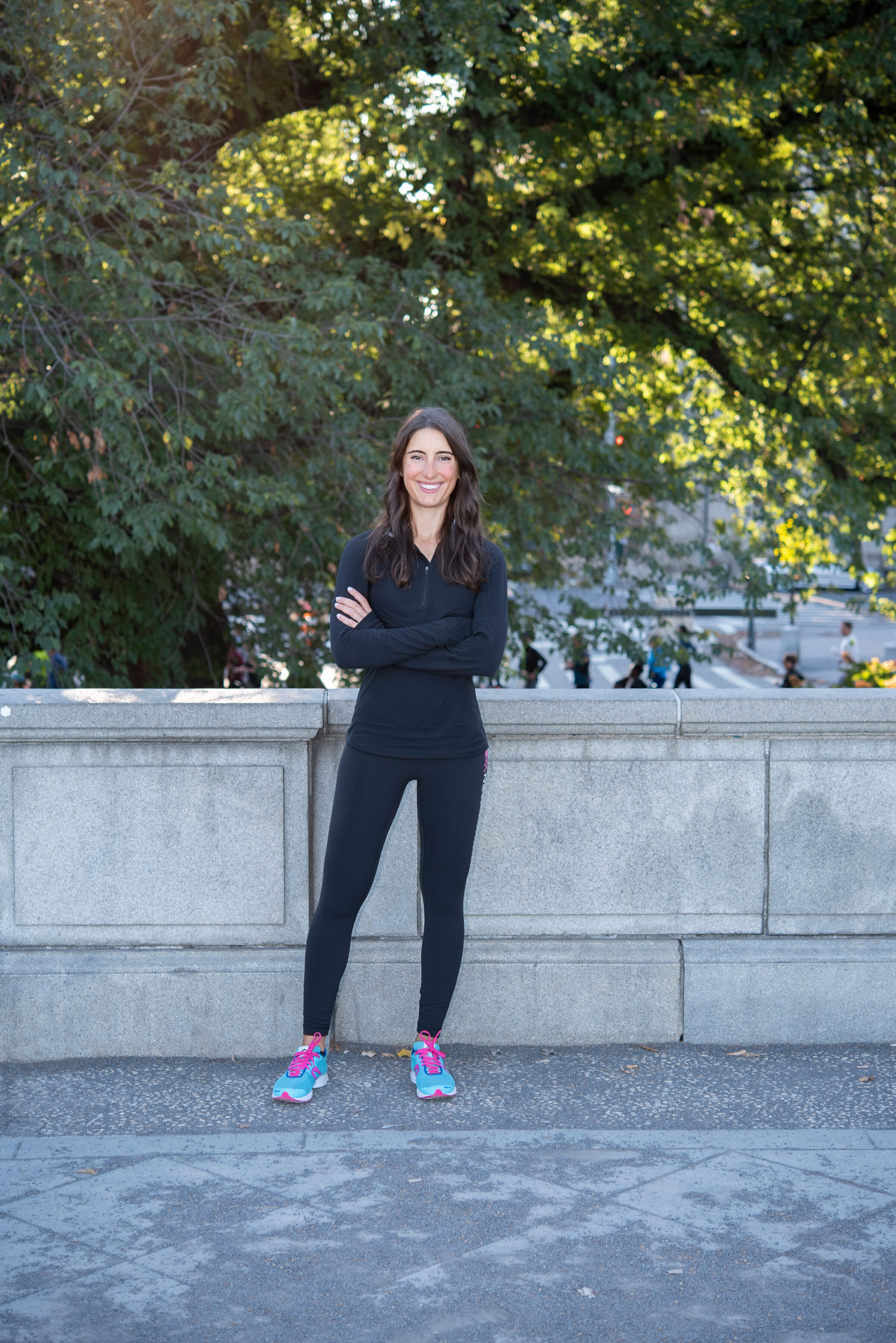The first step is acceptance: A good run training plan should include strength and mobility work. As much as most runners love the simplicity of throwing on a pair of sneakers and heading out the door, making sure your muscles are strong and limber enough to withstand the repetitive stress of running is essential for long-term health and performance.
Of course, knowing how and where to incorporate additional training sessions can be tricky. If you're an intermediate or advanced runner, you may feel that there's no time left in the day after your many miles spent on the road, track and/or trails. And if you're a beginner runner, you may already feel overwhelmed by the sheer amount of advice out there on how to get started and make progress.
So, the next step is identifying your individual needs and goals: You may be a beginner runner prepping to run a 5K, an intermediate runner looking to increase speed or a long-distance runner focusing on increasing distance. Whatever your goals are, you'll want to prioritize a consistent training schedule that combines running with strength and mobility work. When it comes to the latter, quality beats quantity—if you can't keep it up, you may need to scale it back. By sticking with the right plan for you, you can improve your performance and even avoid injury.
Read on to discover our expert-sourced guidance for how to train smartly outside of your running program, or jump ahead using the links below:
- Strength and mobility 101: The basics of these complementary forms of training
- Benefits: How this training will help you improve as a runner
- Creating a training plan: Make sure your training aligns with your goals as a runner
- Managing stress and effort: Avoid injury or burnout from the added training load
- Start training: A few simple exercises to help you get started
Strength and mobility 101
Do a quick online search on "strength and mobility training for runners" and you'll find a range of advice and recommended exercises, from familiar to complex, all labeled as the most crucial for your success as a runner. The truth is that your needs will evolve as you progress with your training and learn more about how your body responds to your weekly running schedule. But by understanding the fundamentals of strength and mobility training, you can make informed decisions about what kinds of exercises to include in your routine.
What is mobility training?
Often, people conflate mobility work with static stretching, or holding a stretch for several seconds. But the purpose of mobility training is to both elongate muscles and increase range of motion, which is a different outcome from flexibility. "Even if you can touch your toes … you may have a deficiency in mobility," says Steph Bennett, senior manager for supply planning at REI and running coach for Cascade Endurance.
Static stretching-holding a foreword fold, for example-can feel good and result in greater flexibility. But the practice rarely mimics the movement of running and can actually cause your muscles to be too relaxed, especially when used as a pre-run warm-up.
Running requires a delicate balance of mobility and strength that can be counteracted by over-stretching. In contrast, dynamic stretching more clearly mimics the actions of running by utilizing movements that will increase the range of motion needed to run safely and effectively. Examples of dynamic stretches include side lunges, bent-knee leg swings, or even unweighted, single-leg deadlifts.
What is strength training?
Strength training-which typically utilizes bodyweight or additional weights-builds strength within our muscle fibers. Most strength training programs for runners target specific areas of the body where improved strength can reduce risk of injury or improve performance. For example, core work is important for runners, since strong abdominals will help maintain form as the body tires. Strengthening major muscles groups in the legs like the glutes, quads, calf muscles, and hamstrings is also key for runners since those muscles help propel us forward; if they're weak, our more fragile joints end up taking on extra load.
Previously, many strength-training plans for runners recommended low-weight high-rep routines to mimic the repetitive movement of running and increase muscular endurance. However, more recent studies have shown that heavy, low-rep strength training is more beneficial to runners; the act of running already trains your muscular endurance, so when you train outside of running, you want to focus on muscular strength.
Mobility vs. Strength
OK, so now that you've been briefed, you may not be surprised to learn that mobility and strength training often overlap. A weighted single-leg deadlift, for example, can increase mobility by testing pelvic alignment and hip extension, while also building strength by loading the hamstring and posterior chain muscles, and requiring core strength for balance.
Experts say that one of the best ways to improve range of motion is to incorporate weights. For example, someone with stiff ankles may benefit more from weighted squats than from squats that only utilize bodyweight.
If you're new to strength and mobility training, it's OK to start with bodyweight and work your way up. Progressive overload, or increasing the stress on your muscles over time, is what helps increase muscular strength. However, if you have some experience with strength and mobility training or do regular speed training, you may want to include weights. If you're unsure of how to safely perform weighted exercises, consult a certified personal trainer or physical therapist.
 Benefits
Benefits
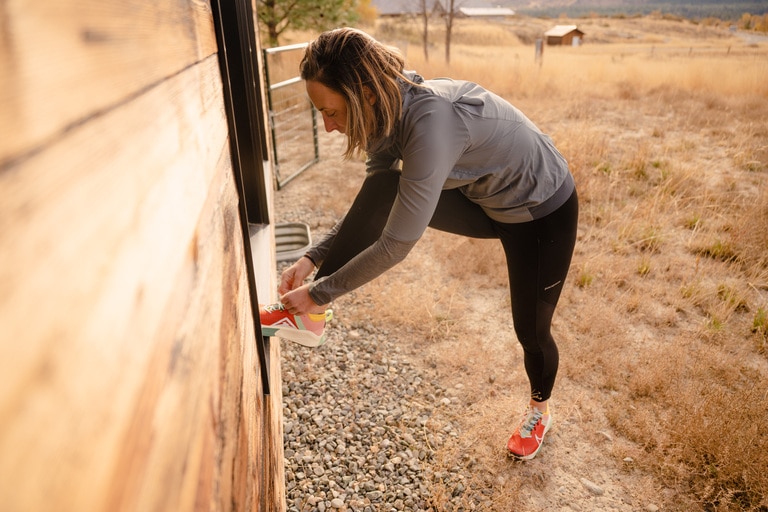
It's the runners' edition of pandora's box: plantar fasciitis, patellar tendinitis (aka "runner's knee"), shin splints and more. If you've been running for more than a year, you've probably experienced a few of these flare-ups. Overuse injury, or injuries caused by doing too much too soon, are common in runners not because the activity is inherently dangerous or unhealthy, but because beginner runners often underutilize strength and mobility training. Plus, a case of runner's high can make it easy to increase mileage or pace too quickly.
Beyond safely increasing your mileage, fueling properly and getting enough sleep, both mobility and strength training may play a part in reducing risk of overuse injury and helping runners recover from any injuries they may incur.
Mobility training can help runners determine asymmetries or changes in the body, and for some injuries-like those involving the big toe-mobility may play a bigger part in the recovery process. But, according to Victoria Sekely, DPT and run and strength coach, the main purpose of rehabbing an injury should almost always be improving stability and strength, which is easiest done through strength training. "No amount of stretching is going to be helpful for long-term improvements in performance and rehab," Sekely says.
Anecdotal reports support the idea that strength and mobility training may prevent injury, and research demonstrates that runners can achieve as much as an eight percent improvement in running economy with a regular strength training program. "Strength training is really a powerhouse performance tool," says Lindsay Scott, a running coach and physiotherapist at The Runner's Academy.
Creating a training plan
Everyone is different, and it's important to identify goals and potential asymmetries before embarking on a new training plan. For example, someone training for a marathon will have different needs from someone training for a 5K. Basic mobility assessments with a trained physical therapist can help provide a roadmap for your body's needs.
On a budget?
For those who can't access a physical therapist, Bennett recommends doing basic mobility exercises in front of a mirror. She says the book, RUNNING: REWIRED by James Dicharry, can be useful for runners looking to assess asymmetries and range of motion on their own. When thinking about mobility, runners should consider whether they're able to balance easily on one foot, what their posture looks like, and whether they have full range of motion while doing mobility exercises.
And while mobility is important, recreational running doesn't require extreme mobility. "We don't need our leg going above our head," says Sekely. Tightness in your hamstrings, for example, is normal in most runners and rarely poses a problem.
Busy schedule?
When determining your unique needs and creating a training plan, it's also important to consider your schedule, and what you'll have time to include. Most experts agree runners can start by incorporating mobility and/or strength work two to three times a week for 10-30 minutes. Consistency is what's most important, and experts warn you shouldn't feel like your routine is overwhelming you. If you only have an hour to run, Scott recommends using the first 5-10 minutes on strength or mobility, rather than forcing yourself to carve out additional time elsewhere. She says the performance potential from consistently showing up for strength training is greater than it is for extending easy runs by a few minutes.
Periodize your training
Experts also note that training plans can vary based on whether you're training for a race, or in an "off-season" - a time when you can focus more on strength or mobility. When you increase your mileage again, you can reduce time spent on strength training, with the understanding that your training plan will move in cycles. Some runners like to align these cycles with seasons, so they're running more when the weather is more tolerable and strength training indoors when weather is less hospitable or extreme.
Managing stress and effort
Runs and strength workouts can be done on the same day, but experts recommend that runners avoid stacking "hard" workouts day after day. In fact, in order to prevent overtraining syndrome, illness and injury, eighty percent of your training should feel relatively easy. This advice applies to overall training, not just runs. Runners should attempt to plan ample recovery time - more than 24 hours - after both hard runs and hard strength training sessions and remember that strength training does not have to leave you sweaty, with a racing heart.
It's also important to consider other stress factors. A study from 2010 found that for endurance athletes, psychosocial factors like stress have a larger impact on injury than training volume. Another study from 2020 found that a single night of less than seven hours of sleep led to a 51% increase in injury.
Scott, who encourages her clients to think of strength training and running as pieces of a pie, says that as the "life" piece of the pie increases, you should scale training back, accordingly. She encourages runners to have flexibility in their training plans. "I would rather you be a hair under-trained and healthy, than overtrained or injured," she says.
Start training
While an individualized plan is helpful, there are some basic mobility and strength exercises most runners can benefit from. You can mix and match according to time and preference (even reserving different types of movement for different days). Or, if you're more advanced, perform the following exercises as supersets, completing (A1, A2) x3 before moving on to (B1, B2) x3 and so forth. Make sure to take ample rest between sets, performing 2-4 sets of each exercise depending on your level.
Note: Consult a medical professional before you take on any new physical activity. If you have no previous experience with strength and mobility exercise, consult a physical therapist or trainer in person to make sure you maintain proper form and avoid injury.
Unilateral and single-leg exercises that mirror the action of running
A1. Single-leg deadlift
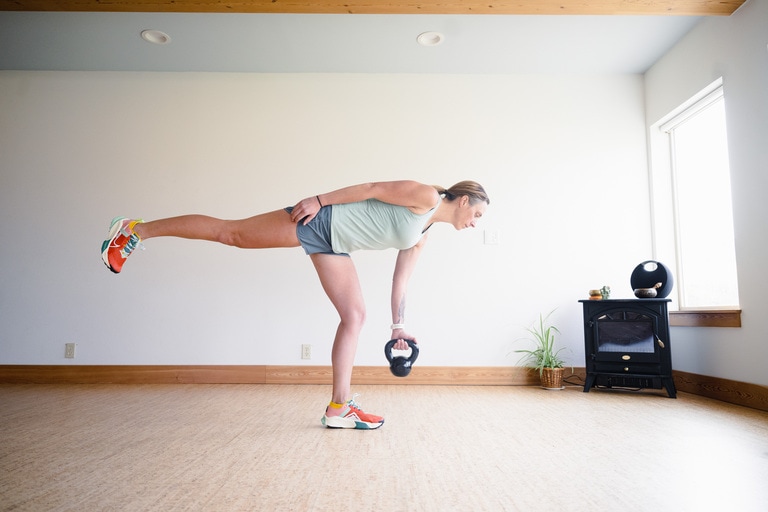
Stand with your feet hip width apart. With a slight bend in the standing leg, slowly lean forward over the standing leg until your back is flat (do this without without bending the standing leg further as you lean over), while allowing your opposite leg to lift behind you in an extended position.
If using weight, hold a dumbbell or kettlebell on the same side as the standing leg. For example, if your standing leg is your right leg, you would hold the weight in your right hand, allowing the weight to hover over your right foot in the extended position.
During this movement, slowly lower and then come back up to your standing position at a normal tempo. You should feel this in the glute and hamstring of your standing leg. Perform 6-12 reps depending on level. Switch sides.
B1. Single-leg glute bridge
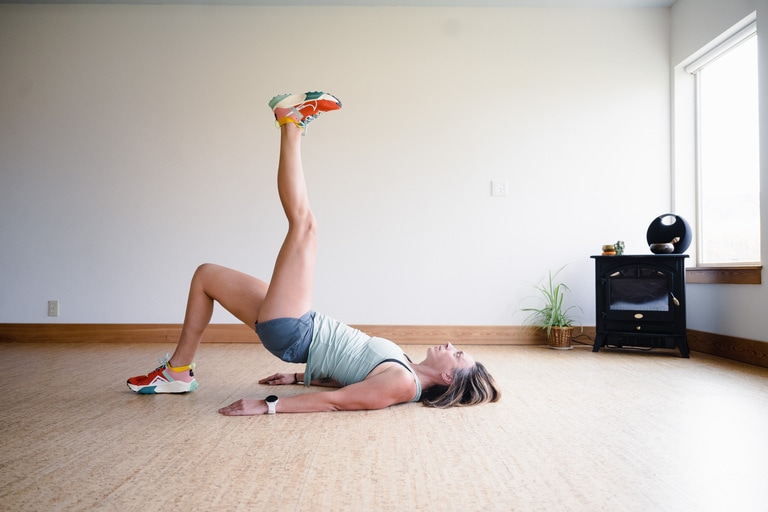
Lie on your back with your feet flat on the floor and hip width apart. Lift up one leg, extending it towards the ceiling. Push up from your lowered foot into a half bridge, keeping the pelvis tucked under and engaging the glute of the lowered leg, and the core. Perform 6-12 reps depending on level. Switch legs.
C1. Singe-leg step-up
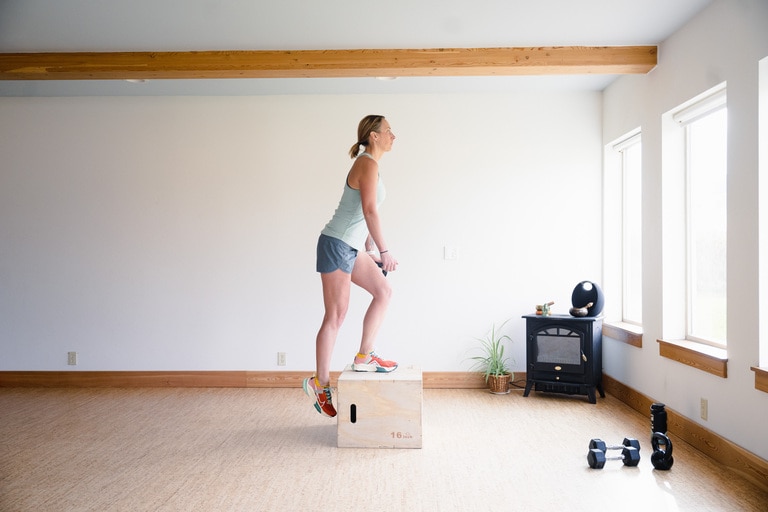
You'll need a sturdy box or step to perform this movement. Stand in front of your box or step with your feet hip-width apart. Place one foot onto the box or step and slowly step up. You'll hinge slightly forward at the hips as you step up, but be sure to keep your back straight. Don't use momentum or the back leg to push you up; keep the movement controlled, using mostly the glute in your working leg to lift you and your core to stabilize you. If you'd like, hold a dumbbell or kettlebell in the hand on the same side as your working leg. Perform 8-10 reps, then switch legs.
Exercises that load muscles in areas used most often while running, including the legs, feet and ankles
A2. Squat
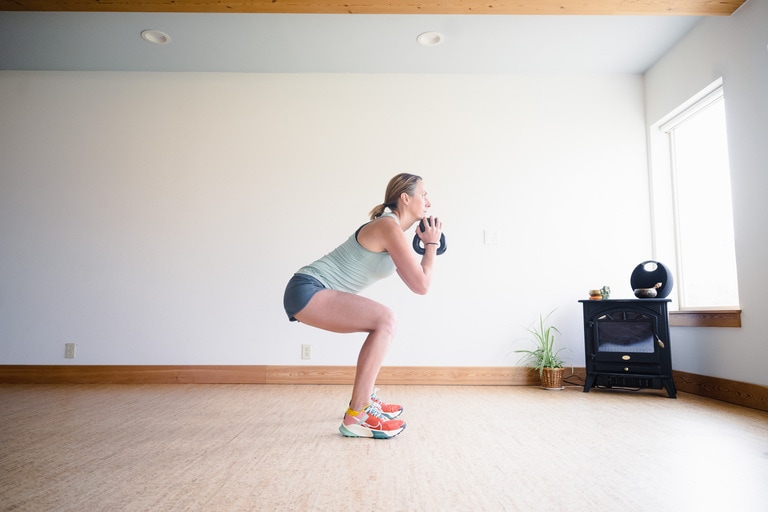
There are several ways to do a squat, depending on the muscles you want to load. To focus on the quads, perform a squat with the feet slightly wider that hip-width apart and parallel, facing forward. As you lower, sit your hips back and keep the knees tracking over your second toes. For a goblet squat, hold a kettlebell or dumbbell with both hands in front your your chest. Perform 8-15 reps.
B2. Single-leg calf raises
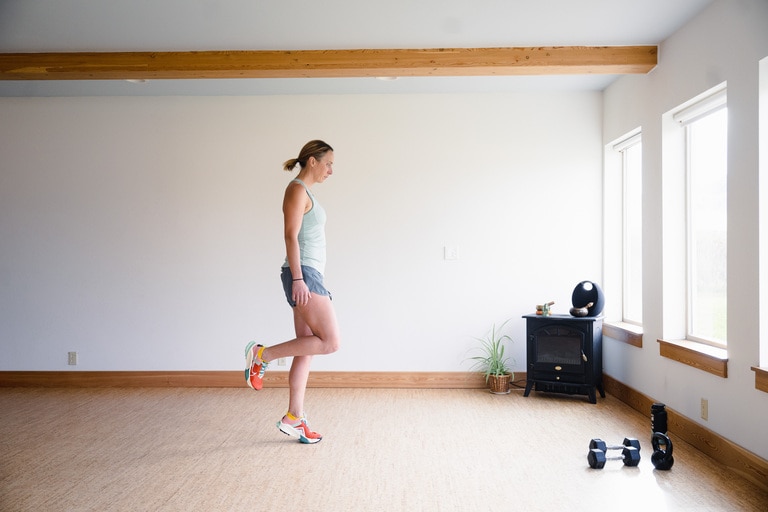
This one's as simple as it sounds. Standing on one leg, raise up onto your toes, engaging the calf muscles, and then slowly lower your heel to the starting position. Perform 10-20 reps, then switch legs. You should feel this throughout the back side of your standing leg.
To increase the range of motion, you can stand on a box or stool, with the ball of your foot on the platform and your heel off the platform. When you lower, you'll lower your heel slightly below the platform.
If including weight, hold a dumbbell or kettlebell on the same side as your standing leg.
C2. Farmer's carry
Carry a kettlebell or two large dumbbells in each hand, arms lowered by your sides. Walk 5-10 steps forward and then turn around and come back, keeping the upper and lower body aligned, pelvis tucked in a posterior tilt (so that there's no curve in your spine) and core engaged.
Core work
A3. Plank
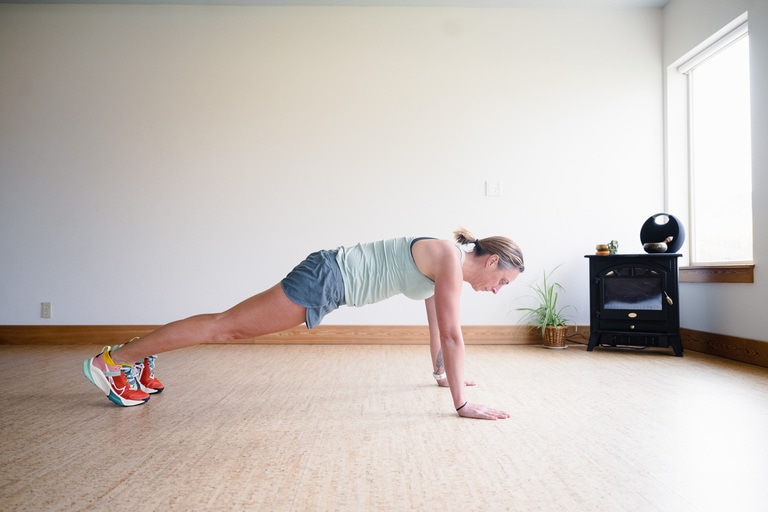
Starting in the table-top position, come up onto your hands and feet. Place your arms parallel and shoulder-width apart, pushing out from the shoulders and engaging the core. The legs should also be parallel to each other and no further apart than hip width (though for a challenge, you can place them closer together). Hold for 20-60 seconds.
B3. Side plank
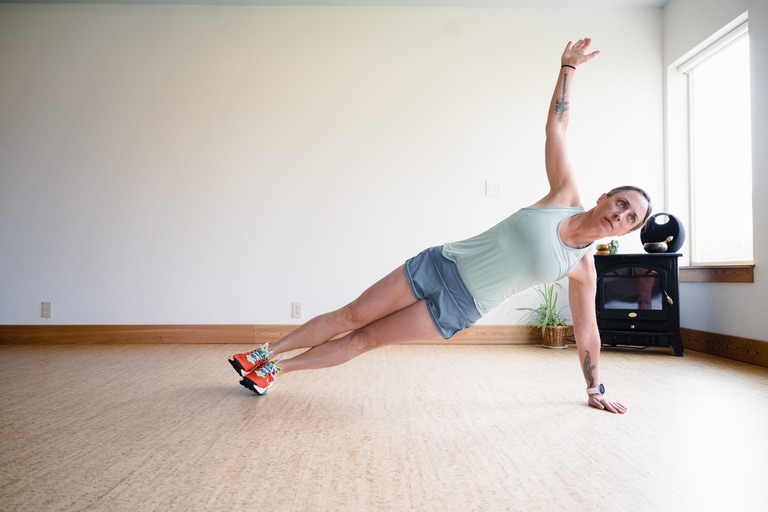
From the plank position, turn over to one side-allowing the top leg lie on top of the bottom leg-while engaging both legs. Your bottom arm should be perpendicular to your shoulder, with that hand pushing out from the ground while you engage your obliques. Your top arm should be up and perpendicular to the ceiling. Hold for 20-60 seconds on each side. To modify, place a your bottom knee on the floor.
Upper body work incorporating pushing and pulling motions for maintaining posture while running
C3. Push-ups
From the plank position, lower down until your arms are in or near a 90 degree angle before pushing back up. Keep your hips in line with your upper body, preventing them from sinking or hiking up. If you're unable to perform at least 5 controlled reps in good form, lower onto your knees, making sure your hips and core remain in line with your upper legs. Perform 5-10 reps.
Finisher: Plank rows
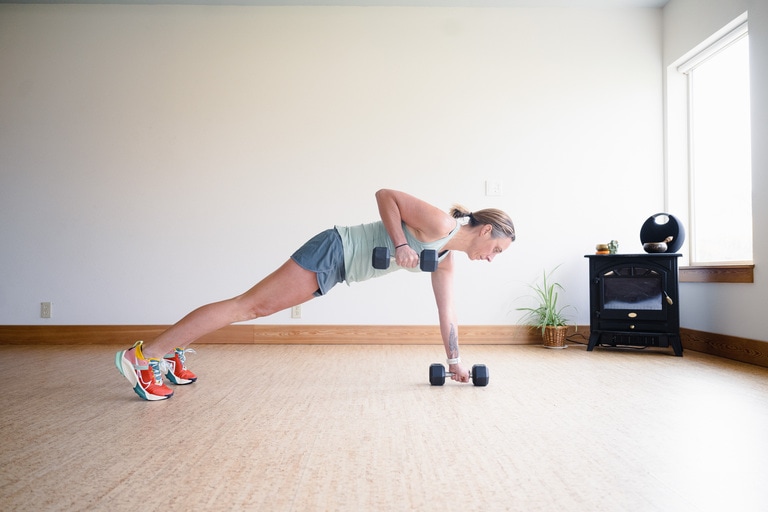
In the plank position-and holding a light-to-medium dumbbell in each hand-engage the core while you lift up one dumbbell, stopping when the arm reaches the waist. Your body will slightly adjust its weight to the side with the dumbell still on the ground, but try not to twist your body. Lower the dumbbell back down and then perform the same movement on the opposite side. Perform 5-10 reps per side or, if performing as a finisher, complete as many reps as you can until exhaustion.
Additional training tips: Rotational movement is also important. While running takes place in a single plane of forward motion, the forces our bodies are up against exist in multiple directions. Scott says yoga can be helpful for incorporating more multi-directional movement. Eccentric movement - slowing down or speeding up as you move through strength exercises - can also improve running performance.
Scott has a pre-run warm-up she recommends to runners who aren't sure of their needs. By starting small, staying consistent, and working with - not against - life's other obligations, runners can build strength and mobility that supports injury prevention and recovery, and builds power.
Related Articles
- Yoga for Runners
- How to Cross-Train for Trail Running
- Stretches for Running
- Foam Roller Exercises
- Prepare to Run Your Best Race
- Best Road Running Shoes of 2022
- Best Trail Running Shoes of 2022




